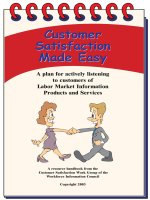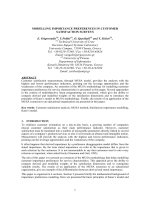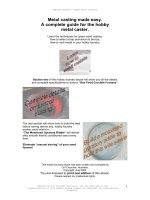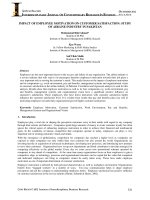customer satisfaction made easy
Bạn đang xem bản rút gọn của tài liệu. Xem và tải ngay bản đầy đủ của tài liệu tại đây (495.51 KB, 35 trang )
Customer
Satisfaction
Made Easy
Customer
Satisfaction
Made Easy
A plan for actively listening
to customers of
Labor Market Information
Products and Services
A resource handbook from the
Customer Satisfaction Work Group of the
Workforce Information Council
Copyright 2003
Introduction – Why Measure Customer Satisfaction? 1
How to Measure Customer Satisfaction 2-3
Step 1 – Pick a Product or Customer Group 4-6
Step 2 – Set the Stage for Assessment 7-31
What do you want to find out? 7-10
Sample Problem Definition Statement 8-10
How you can best find the answers? 10-31
Qualitative Approach 11-12
Quantitative Approach 13-14
Guide for Using Focus Groups 16-18
Guide for Using A Mail Survey 19-20
Guide for Using A Telephone Survey 21-23
Guide for Using a Personal Interview 24-26
Guide for Using an Internet Survey 27-29
What to Ask 30
Sample Survey 31
Step 3 – Conduct Research and Take Action! 32
Documenting Demand
Conclusion 33
Table of Contents
Topic Page
Introduction –
Why measure customer satisfaction?
Because it’s required! The Workforce Investment Act of 1998
says states need to
“consult with customers about the relevance of the
information disseminated through the statewide employment statistics
system, in order to continuously improve the system.” The two key
parts of this statement are:
• Consult with customers
• Continuously improve the system
It’s also a requirement of the One Stop LMI grant from the Employment
and Training Administration!
Because we have to prove “return on investment!” In times
of increased accountability in government, every activity needs to prove
that taxpayers’ money is used efficiently and effectively. To ensure that
LMI products retain their value to customers, we need to continuously
ask customers if our products are meeting their
needs. We also need to create new products that are
responsive to customer demands. Asking our cus-
tomers about our products provides proof that LMI
products are a good investment.
Because we can’t afford not to! With
limited funding, we have to make sure that every dol-
lar we spend on developing and disseminating infor-
mation products (whether its for printing or updating
a website) is being spent on a product people will
use. The BEST way to make sure our products are
being used is to ask the people who use them.
Customer satisfaction assessment is a great opportunity
for states to make positive changes in the future
of the labor market information system!
1
How to measure
customer satisfaction?
This handbook will help states make customer
satisfaction assessment as easy as 1, 2, 3! In order to
make it this easy, there are some things you should do
and should know.
Form an evaluation team.
The team will oversee the collection of
customer satisfaction feedback and then perform three responsibilities.
1. Make changes to products and services based on that feedback;
2. Share satisfaction processes and results with other states;
3. Share satisfaction processes and results with federal
representatives to make systemic changes.
Consider having a publications specialist, an analyst and a projections
professional on your team. This team may already exist as the group who deter-
mines your LMI product content.
Customer satisfaction assessment does not
necessarily have to be a statistically rigorous exercise.
The process outlined in this handbook is based on solid descriptive
research methodology, but it is different from the types of research normally
conducted in “LMI shops.” While you may have to meet strict standards for
response rate based on a stratified random sample to meet the requirements of
the Bureau of Labor Statistics, customer satisfaction assessment is based on a
“dialogue” with your customers. This dialogue may not be conducted the way
you would conduct a BLS survey.
You should document the demand for your
products and services.
In addition to finding out if customers are satisfied with your products,
find out how many are actually using them, how they are using them and where
those users are located. We have a special section at the end which addresses
this issue.
2
Create Customer Lists.
Many of the processes outlined in this handbook will require you to have
a list of your customers. You may want to consider creating these lists if you do
not have them already. These are lists of customers who receive or use a partic-
ular document or LMI product you produce.
You have many tools in the toolbox of customer
satisfaction research.
You may want to conduct a survey, you may want to have a focus group
or conduct interviews with your main customers of a particular product.
Remember, when you ask just one customer their opinion of a product, you
have started to listen to the customer. When you change a document based on
what a customer said, you are engaged in the process of continuous improve-
ment. This leads to the final point:
You can’t do it all at once!
This handbook will walk you
through conducting customer satisfac-
tion research. At first, it may seem a
daunting task to find out what all your
customers think about all of your prod-
ucts. But, you have to start somewhere
and you can’t do it all at once. Remain
calm and dig in!
3
Pick a Product or Customer Group
State LMI providers should be producing docu-
ments for particular customer groups. According to the
Workforce Investment Act, states should be serving the
following customer groups:
•
Businesses make decisions about product and financial markets, busi-
ness location, and employee recruitment, compensation, and training.
• Individuals, including young people and adults, make choices about
careers, education, training, and job search.
• Elected Officials and Policy Makers, including Workforce Investment
Boards, make decisions about law, policy, budgets, and regulations.
• Program Planners determine what workforce and economic develop-
ment services to provide, and evaluate program performance.
• Education and Training Providers, including teachers and curriculum spe-
cialists, design, deliver, and evaluate programs that develop students’
knowledge and skills.
• Intermediaries, such as parents, counselors, teachers, mentors,
placement workers, and case workers, assist others in choosing edu-
cation and training opportunities, and in finding employment, and
• Researchers study how the labor market works, and conduct policy
research. The mass media may be included in this category.
Take a look at the LMI products
and services your state produces.
Which customer groups use each of the
products? Create a grid, like the sam-
ple that follows, which shows the cus-
tomer groups and the products you pro-
vide for them.
Step
1
4
MATRIX
CUSTOMER GROUPS
Career
Handbook X X X
Hot Job Sheet X X X
Labor Market
Trends X X X X X
Wages 2002
X
Commuting
Patterns X X
Unemployment
Rate X X
WIB
Conference X
Website 1
XXX
Website 2
X
Website 3
X
At each intersection on the grid,
you should be assessing satisfaction.
LMI
PRODUCTS/
SERVICES
Employers
Individuals/
Job Seekers
Elected officials and
Policy Makers
Program planners/
Workforce Boards
Education and
Training Providers
Intermediaries
Researchers
Media
5
Once you identify which customers are using what products and services,
you can measure customer satisfaction by starting with either of two paths:
• start with a product, or
• start with a customer.
As noted on the previous grid, if your state is about to re-publish a
Career Handbook, you may want to ask people in the three customer groups
that use the document if they are satisfied with it. In that case, you would be
starting with a product.
You can be in tune with the changing needs of customers by conduct-
ing needs assessment without discussing an existing product. For example,
each year employment statistics agencies must confer with local workforce
investment boards to discuss information needs. This is an opportunity to
conduct a needs assessment. Ask them about how they use data in their core
business functions and if workforce information could help them do their
work. This may help you prioritize which information products and services
you provide and customize those products for their specific needs.
6
Set the Stage for Assessment
There are two things
you need to do in step two:
1. determine what you want to find
out, and
2. determine how best to find the
answers!
The rest of this step walks you through
this process and gives you examples.
What Do You Want to Find Out
You should develop an Assessment Statement. This merely helps you “think
through” your descriptive research process. It may seem obvious when you
complete it, but it will help guide you. This is what should be in and should
be answered in your statement:
• A general description what you want to find out and from whom.
• A basic question the research needs to answer
• What you want to determine in your research?
• Management objectives, such as:
✓ Why you are doing the research?
✓ What will be the uses of the information you learn?
✓ Why is it important that you do the research?
✓ What is the general setting for the research?
✓ Who are you going to assess?
• What data collection technique will you use and why?
• When will you do it?
• How much time/money can you spend doing it?
• Who will do it?
The following pages provide an example of a
completed Assessment Statement.
DETERMINING THE ATTITUDES
Step
2
7
OF CAREER COUNSELORS CONCERNING
CAREER GUIDES AND POSTERS
Assessment Statement
General Description: To assess satisfaction with career guidance mate-
rials delivered by the State Department of Labor
(DOL) and determine methods for improving
those products for customers.
Basic Research Question: In what ways can career guidance materials be
improved to assist those who advise students on
career goals?
Research Information Questions:
- To determine the level of satisfaction with
existing career materials, specifically Guides to
Career Choices and accompanying posters;
- To determine the most effective attributes of
career materials which should be retained in
future publications;
- To determine the least effective attributes of
career materials which should be omitted in
future publications;
- To determine attributes of career materials from
other states which may provide better
alternatives for presenting information to career
guidance personnel.
Management’s Objectives:
Why is this research being done?
We are required to assess customer satisfaction
with products as part of its funding grant from
the U.S. Dept. of Labor, Employment and
Training Administration (ETA), and needs cus-
tomer satisfaction input to guide its continuous
improvement efforts. This assessment is in par-
tial fulfillment of this obligation. We also want
to create a more useful product.
8
SAMPLE
What are management’s intended uses of the
information?
DOL management will document comments from
customers and, as necessary and fiscally possible,
make changes to career information materials.
How important is the research?
Limited resources to fund printing require DOL
management to ensure that only the most useful
information is published.
What is the general setting for the research?
Labor Market Information has been published by
DOL for many years under cooperative agreements
with the U.S. Dept. of Labor, Bureau of Labor
Statistics and Employment and Training
Administration. Career guidance materials are part
of meeting these and other mandates (e.g., the
Workforce Investment Act of 1998) to serve edu-
cators. DOL wants to ensure that this key target
group is being effectively served.
Who is to be assessed?
The career guidance personnel in two vocational
districts in the state will be invited to participate in
focus groups.
Data Collection Technique: Because the group members can be identified by
name, a focus group
will be held in each of two
districts with approximately 7 to 12 persons in
each group. Most of the questions will be open-
ended to allow for maximum response by the per-
sonnel. One group is from a suburb. The other
group is from the more rural area. The two career
guidance centers in the above-mentioned commu-
nities will be contacted for a list of names of per-
sonnel who use the materials. These individuals
will be invited to attend the focus group until a
maximum of 12 people are confirmed in each loca-
tion. The focus groups will be held at the voca-
tional offices in the communities noted.
Timing: The research will be conducted
May 19 - 30, 2003.
9
SAMPLE
Researchers: The focus groups will be conducted by
an independent research company.
How You Can Best Find the Answers
Notice that in the above example a focus group was selected. There are many
options in addition to focus groups. The Customer Satisfaction Work Group
recommends one or a combination of these five:
• Focus Group
• Focused Personal Interview
• Mail Survey
(can be handed out at
a conference, too)
• Internet Survey
• Telephone Survey
Notice that the first two data collection techniques mentioned above involve
one-to-one personal contact with a group of customers. The last three involve
sending or handing out a survey. You can get both qualitative (comments) or
quantitative (numbers) information from either source. So, which should you
use? There are some ideas on the following pages.
10
A GUIDE FOR USING
A QUALITATIVE
APPROACH
General Description and Purpose
This is an approach that is primarily designed to gather information
using open-ended questions to allow for more in depth interviewing.
Appropriateness
When you want more insights into a question or general opinions,
this is a good method to use.
Recommended LMI Products or Services
This can be for all products and services that you provide.
Types of Questions
Normally open-ended questions are used. (Such as “how do you use
these” or “how do you feel about this.”) However, do not hesitate to
ask closed-ended questions but not too many. (Such as “how many
students do you serve.”)
Customer Groups
All customer groups are appropriate.
Selection of Customers
A nonrandom, subjective method may be better than a random,
objective method. Select people who you feel will share feelings
and ideas.
Number involved
A relatively small number, say fewer than 20, can be very effective.
But, you may want to ask open-ended questions on a formal,
quantitative survey of a particular customer group. This is appropriate
but remember that the answers to open-ended questions are the most
difficult to analyze. If you ask 300 people a “why” question, you
will spend many hours just analyzing that one question!
Typical Response rate
Unless you are asking the open-ended question of a person, you may
find that many people do not answer open-ended question on a
written survey.
11
Method of Conducting the Exploratory Study
There are many methods available. Focus groups are commonly
used. However, you can do individual interviews. This differs from
a focus group since there is not the dynamics of reaching group con-
census. Another technique is the “think aloud” method. Comment
cards can also provide insights.
Buying a program to document and tabulate the open-ended
responses can be beneficial.
Typical Costs
Will normally be cheaper than quantitative methods due to a smaller
sample size.
Time Required
Can be shorter than doing quantitative research.
Staffing Needs
You will need persons skilled in leading a group or interviewing
persons. Having a staff member trained in analyzing open-ended
responses would be very helpful.
Benefits of Using this Approach
You can obtain in-depth customer feedback and gain an understand-
ing of how information is actually used by the customer. You have
much flexibility in your approach. The approach can be very infor-
mal. Using a complex sampling method is not needed. You also
will not normally need, nor want, a large sample size.
Cautions in Using this Approach
If you are doing a focus group or interviews, you cannot project the
results to a larger group of people. If you are analyzing the results
of open-ended questions asked on a quantitative survey, you can
project the results to the larger group. The problem becomes
analyzing the answers in some meaningful manner.
12









